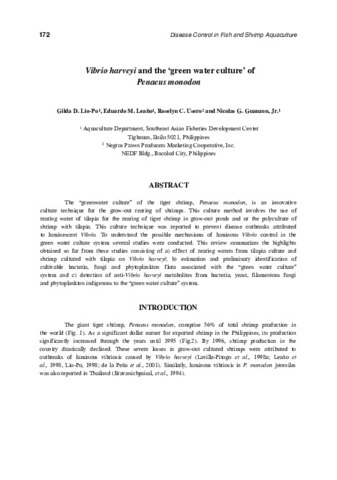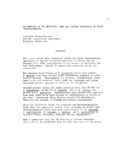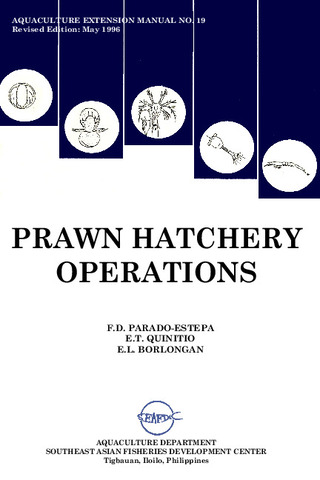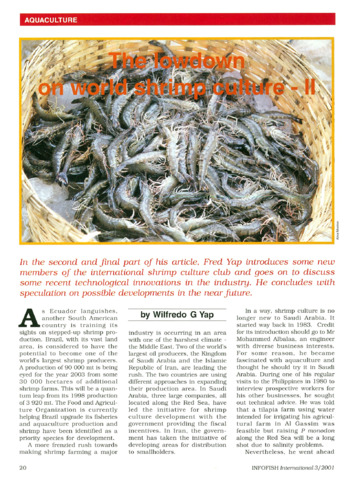Vibrio harveyi and the 'green water culture' of Penaeus monodon
- Global styles
- MLA
- Vancouver
- Elsevier - Harvard
- APA
- Help

View/
Downloads: 2,050
Date
2002Page views
7,858AGROVOC keyword
Taxonomic term
Metadata
Show full item record
Share
Abstract
The 'green water culture' of the tiger shrimp, Penaeus monodon, is an innovative culture technique for the grow-out rearing of shrimps. This culture method involves the use of rearing water of tilapia for the rearing of tiger shrimp in grow-out ponds and on the polyculture of shrimp with tilapia. This culture technique was reported to present disease outbreaks attributed to luminescent Vibrio. To understand the possible mechanisms of luminous Vibrio control in the green water culture system several studies were conducted. This review summarizes the highlights obtained so far from these studies consisting of a) effect of rearing waters from tilapia culture and shrimp cultured with tilapia on Vibrio harveyi; b) estimation and preliminary identification of cultivable bacteria, fungi and phytoplankton flora associated with the 'green water culture' system and c) detection of anti-Vibrio harveyi metabolites from bacteria, yeast, filamentous fungi and phytoplankton indigenous to the 'green water culture' system.
Suggested Citation
Lio-Po, G. D., Leaño, E. M., Usero, R. C., & Guanzon, N. G., Jr. (2002). Vibrio harveyi and the ‘green water culture’ of Penaeus monodon. In Y. Inui & E. R. Cruz-Lacierda (Eds.), Disease Control in Fish and Shrimp Aquaculture in Southeast Asia – Diagnosis and Husbandry Techniques: Proceedings of the SEAFDEC-OIE Seminar-Workshop on Disease Control in Fish and Shrimp Aquaculture in Southeast Asia – Diagnosis and Husbandry Techniques, 4-6 December 2001, Iloilo City, Philippines (pp. 172–180). Tigbauan, Iloilo, Philippines: SEAFDEC Aquaculture Department.
Type
Conference paperISBN
9718511601
Related items
Showing items related by title, author, creator and subject.
-
An overview of the nutrition, feed and feeding techniques of prawn penaeid/shrimps
Piedad-Pascual, Felicitas (Philippine Council for Aquatic and Marine Research and Development, 1989)This paper echoes what transpired during the first International Conference of Penaeid Prawns/Shrimps held in Iloilo City in December 4-7, 1984, particularly on the Nutrition nd Feed Development. Around 25 papers were ... -
Series: Aquaculture extension manual; No. 19
Prawn hatchery operations
Parado-Estepa, Fe D.; Quinitio, Emilia T. ; Borlongan, Emeterio L. (Aquaculture Department, Southeast Asian Fisheries Development Center, 1996-05)
The manual, an updated version of the 1984 SEAFDEC/AQD manual, presents the underlying principles and step-by-step instructions of prawn larval and post-larval rearing. The techniques described are not only applicable to ...
; Borlongan, Emeterio L. (Aquaculture Department, Southeast Asian Fisheries Development Center, 1996-05)
The manual, an updated version of the 1984 SEAFDEC/AQD manual, presents the underlying principles and step-by-step instructions of prawn larval and post-larval rearing. The techniques described are not only applicable to ... -
The lowdown on world shrimp culture - II
Yap, Wilfredo G. (INFOFISH, 2001)This paper introduces some new members of the international shrimp culture club and goes on to discuss some recent technological innovations in the industry, particularly the polyculture of tilapia (mainly Oreochromis ...






